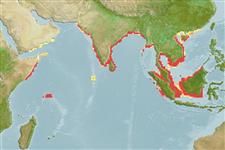Environment: milieu / climate zone / intervalo de profundidade / distribution range
Ecologia
marinhas; estuarina pelagic-neritic; anfídromo (Ref. 51243); intervalo de profundidade 0 - 50 m (Ref. 189). Tropical; 25°N - 5°S, 46°E - 117°E (Ref. 189)
Indian Ocean: Karachi eastward to the Andaman Sea and Penang. Western Central Pacific: Singapore south to Barito River, Kalimantan).
Tamanho / Peso / Idade
Maturidade: Lm ? range ? - ? cm
Max length : 17.0 cm SL macho/indeterminado; (Ref. 189)
Espinhos dorsais (total) : 0; Espinhos anais: 0; Raios anais moles: 80. Body tapering, belly rounded in front of pelvic fins, with 5 to 7 + 9 = 12 to 15 keeled scutes from just behind pectoral fin base to anus. Maxilla almost or just reaching to edge of gill cover. Pectoral fin with 6 long filaments; the branched fin rays longer than those of pelvic fin.
Body shape (shape guide): elongated; Cross section: compressed.
Occurs in fully saline water along coasts and in estuaries, but able to tolerate at least some degree of freshening (e.g. at Aluhaluh on Barito River, Kalimantan). Museum collections suggest that this species is common.
Life cycle and mating behavior
Maturidade | Reprodução | Desova | Ovos | Fecundidade | Larvas
Spawn in school (Ref. 205).
Wongratana, T., T.A. Munroe and M. Nizinski, 1999. Order Clupeiformes. Engraulidae. Anchovies. p. 1698-1753. In K.E. Carpenter and V.H. Niem (eds.) FAO species identification guide for fishery purposes. The living marine resources of the WCP. Vol. 3. Batoid fishes, chimaeras and bony fishes part 1 (Elopidae to Linophrynidae). FAO, Rome. (Ref. 9822)
Categoria na Lista Vermelha da IUCN (Ref. 130435: Version 2025-1)
Ameaça para o homem
Harmless
Utilização humana
Pescarias: pescarias de subsistência
Ferramentas
Relatórios especiais
Descarregue XML
Fontes da internet
Estimates based on models
Preferred temperature (Ref.
123201): 26.5 - 29.3, mean 28.6 °C (based on 618 cells).
Phylogenetic diversity index (Ref.
82804): PD
50 = 0.5001 [Uniqueness, from 0.5 = low to 2.0 = high].
Bayesian length-weight: a=0.00282 (0.00126 - 0.00632), b=3.10 (2.92 - 3.28), in cm total length, based on LWR estimates for this Genus-body shape (Ref.
93245).
Nível Trófico (Ref.
69278): 3.3 ±0.4 se; based on size and trophs of closest relatives
Resiliência (Ref.
120179): Elevada, tempo mínimo de duplicação da população menor que 15 meses (Preliminary K or Fecundity.).
Fishing Vulnerability (Ref.
59153): Low vulnerability (11 of 100).
🛈
